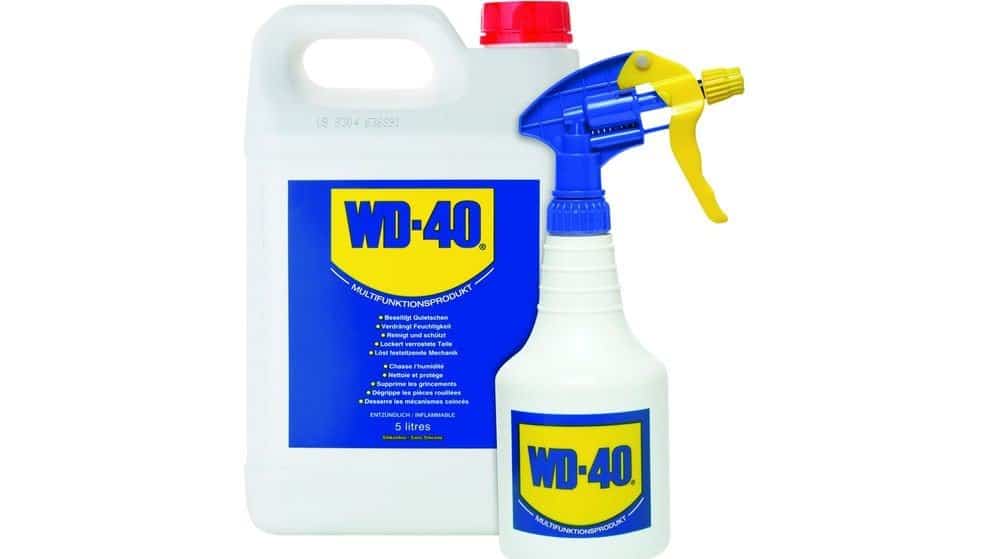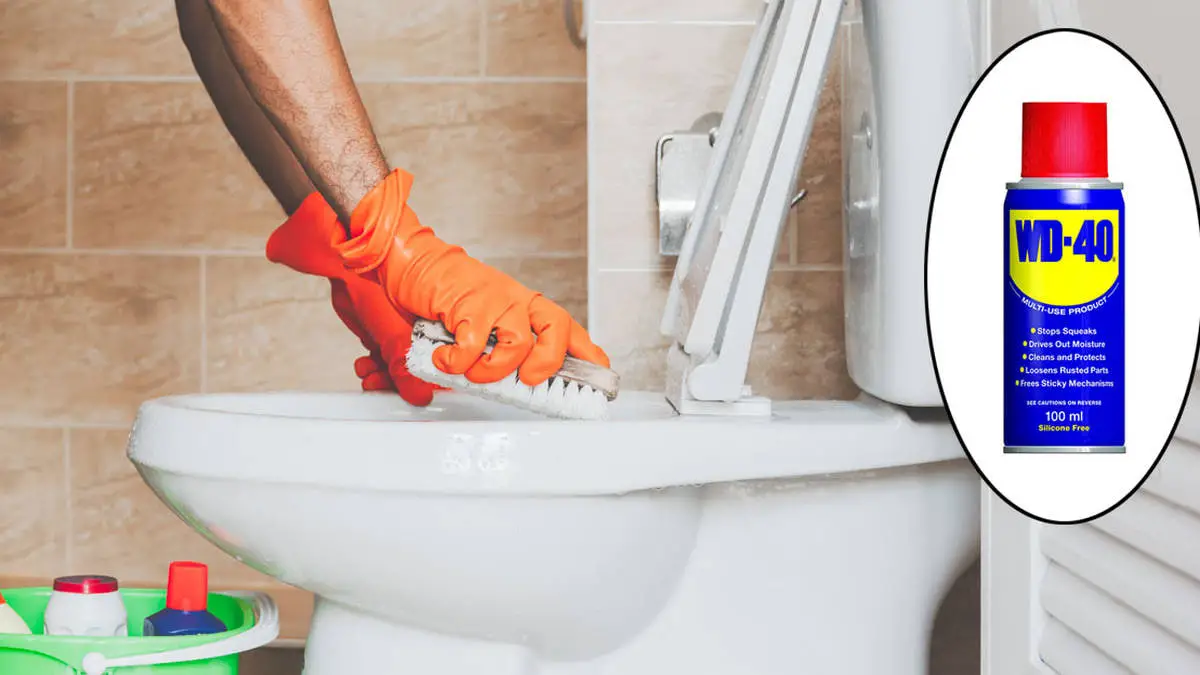Cleaning the toilet bowl is a necessary, if unappealing, task that should be done regularly. Even when you diligently scrub, it can be difficult to remove stubborn toilet ring and limescale stains. Fortunately, there are a few accessible products and techniques available which can help with this problem.
Toilet bowl cleaner and vinegar can both be used to remove these stains, or you can use a strong chemical bleach solution for tougher cases. But beware of the advice to use wd40 in toilet to remove your tough toilet stains — it’s probably more effective than other home remedies but should not be used on a regular basis due to its chemical properties.
CAN YOU USE WD-40 TO CLEAN YOUR TOILET?
WD-40 is usually seen as a handyman’s beloved tool, but did you know it can be used to tackle those stubborn hard water stains that seem impossible to remove? If the tried and true methods haven’t been successful in solving your bathroom woes then WD-40 may just work its magic. Not only does this powerful penetrating oil save hardware from rusting or seizing up – with a little ingenuity, it could rescue toilets too!
Goodbye, hard water stains! With the help of WD-40 and a bit of elbow grease, your toilet bowl will be good as new. Simply spray some around affected areas, wait 15 minutes for it to do its magical work then scrub with a brush – you don’t even have to worry about flushing away any residue; just wipe up with an old rag instead.
While WD-40 may be an effective tool for removing stubborn hard water stains, it’s not a great option if you’re on a septic system. It can potentially strip away the beneficial bacteria from your tank and leave harmful residues behind in your toilet bowl! Instead of flushing frequently to remove these stains, opt for grabbing some paper towels or rags instead; those are more ecofriendly solutions that won’t disrupt the balance within your septic system. When searching through common products at home improvement stores however, make sure to consult our article – we have compiled some of the best TP cleaners specifically designed with folks living off core systems in mind.
WHAT CAUSES TOILET STAINS?
Brown toilet stains can be a real eyesore and difficult to remove, especially when caused by a high concentration of iron and/or manganese in the water. Such marks often appear to be rust, as iron oxide has been formed through the combination of oxygen and iron. Furthermore, other stains, such as black or green marks which are caused by bacteria present in the water and foggy, cloudy patches that come from calcium deposits, can make there toilet look aged beyond its years.
The good news is that all these stains are combatable with the help of a toilet bowl cleaner or regular toilet brush. Both can help to remove tough stains without creating any damaged to your toilet bowl’s porcelain surface.
Hard water toilet stains come in all shapes and sizes, but they are most commonly seen at the bottom of the toilet bowl around the waterline. The reason for this is because hard water contains high concentrations of minerals that can cause pesky buildups, and when combined with oxygen, they form a ring of tough stains known as the “hard water ring”.
To tackle this problem, many have opted to use toilet brushes or specialized toilet bowl cleaners. However, these solutions may only work temporarily, as regular toilet bowl cleaner tends to struggle against harder stains. Therefore, it is important to act fast and take preventive measures against hard water tank build-up if you want to keep your toilet clean for a long time.
HOW TO REMOVE HARD WATER STAINS IN A TOILET USING WD-40
Is your toilet bowl starting to look like an old brown stain-covered rock? Don’t worry, it’s just a sign of hard water stains caused by minerals in the water. Fortunately, WD-40 is here to help get rid of them with ease! Not sure what kind of mineral you have? Brown stains indicate iron and/or manganese while white or cloudy ones are more likely due high amounts calcium present.

- Remove the water at the bottom of the toilet bowl using a cup or a sponge.
- Spray the WD-40 on the toilet bowl targeting the stains.
- Give the WD-40 2 to 5 minutes to dissolve the stains.
- Use the toilet brush to scrub the toilet bowl including the rim and the outlet.
- Flush the toilet to confirm that all stains are removed.
When removing water stains and deposits, it pays to use a light touch with WD-40. For best results – and the most pleasant bathroom experience – seek out the low odor type so you won’t be overwhelmed by fumes while cleaning!
CAN WD-40 UNCLOG A TOILET
If you’re dealing with a clogged toilet, it can be tempting to break out the WD-40 but doing so is not eco-friendly – especially if your house runs on a septic system. Not only will using this chemical disrupt natural bacterial processes inside your tank, thus preventing waste from breaking down at an optimal rate; there are also other tried and true alternatives to help unclog toilets without resorting to harsh chemicals. Find out what they are in our latest post!
OTHER WAYS TO REMOVE TOILET STAINS
Keeping your bathroom smelling fresh and looking spotless requires you to clean your toilet bowl regularly. Although WD-40 may work to remove hard water stains, there are other cleaning methods you can use. Vinegar and baking soda is the most common bathroom toilet stain remover solution.
Start off by pouring a cup of vinegar in the bowl and wait for about one minute before adding a cup of baking soda followed by another cup of vinegar. Swishing the solution around the bowl every 5 minutes for about 30 minutes will get rid of those pesky stains without toxic chemicals or harsh go to toilet cleaner.
Keeping your toilet clean and refreshed is easier than you think! To get rid of tough stains, try a vigorous brushing with the trusty toilet brush for 30 minutes. Don’t forget to flush too – but once weekly, wash it down with some vinegar as an extra preventative measure against build up.
For more persistent messes like rings in the bowl, pumice stone comes to rescue: simply drop one into the water and after 15 minutes’ work its magic softening away grime without scouring or scratching porcelain surfaces.
OTHER WAYS TO USE wd40 in toilet
With its powerful cleaning abilities, WD-40 can be used to tackle messes around the home and beyond. From removing limescale from toilets to lubricating door hinges or unclogging drains – there’s almost no limit on what this versatile product can do!
- To Loosen Toilet Tank/Seat Bolts
Struggling to remove stubborn toilet stains bolts? Try dousing them with WD-40, a penetrating oil. Let it sit for 15 minutes and watch as the rusty parts become loose enough to easily detach from your loo.
2. Cleaning Tiles
Keep your bathroom looking spotless with WD-40! Simply spray it on any tiled surfaces and give it a few minutes to work its magic. Focus special attention around the edges, base of toilet, bathtub or other fixtures for maximum cleaning power. Then wash off thoroughly with detergent – easy as that.
3. Removing gum from surfaces.
Got gum stuck in unexpected places around the house? Little ones can be so tricky! Don’t worry though – just spray with WD-40 and watch it soften up, making removal of that pesky chewing gum a breeze.
4. Preserving tools
Preserve your tools and keep them looking brand new thanks to WD-40, the cleverly crafted agent that prevents rusting. As we know, water plus iron plus oxygen equals rust – but with a few simple spritzes of this magical concoction you can rest assured knowing those letters in its name stand for Water Displacement! Protect what matters most and wave goodbye to rusty hardware; grab yourself some trusty WD-40 today.
Is it safe to use WD-40 in toilet cleaning?
Stop letting hard water stains get the best of your toilet bowl! WD-40 can come to the rescue in removing those pesky areas, but use it sparingly. A small spray will do just fine; no need to douse your loo with more than is needed. Also remember that though this solution may work wonders on tough spots—it’s not intended as a regular cleaner for everyday cleaning needs.
Does WD-40 kill wasps?
Wasps can be pesky visitors in your home, but with the help of WD-40 they don’t stand a chance! This trusty product works as an insecticide to kill wasps and their nests which are usually found tucked away in tight corners or drilled into wooden poles. Don’t let those stingers win – make sure you have some handy for when the inevitable invasion comes along.
What do hotels use to clean glass shower doors?
If you’re looking for a perfectly pristine shower door, the trick lies in some DIY elbow grease and an easy-to-make solution. Just mix 1 part vinegar to 3 parts water, pop it into a spritz bottle and lightly coat both sides of your glass doors with the mixture. Wait five minutes then use a non abrasive cloth along with dish soap to give them that extra luster before drying off completely – result? Shiny cleanHotel Glass.
Can I use WD-40 to clean my toilet tank if I have a septic system?
WD-40 is not the best choice for toilet cleaning. In fact, it will do more harm than good in the long run! Petroleum oils from this product can end up polluting drinking water and nearby bodies of water, as well as impacting bacteria that exist naturally in septic tanks. For your cleanest loo ever (and safest too!), try using natural products such as vinegar, baking soda or even cola instead – these are much better options to get rid of hard waters stains without risking environmental damage over time.
Read more: How to clean tarnished chrome faucets?

